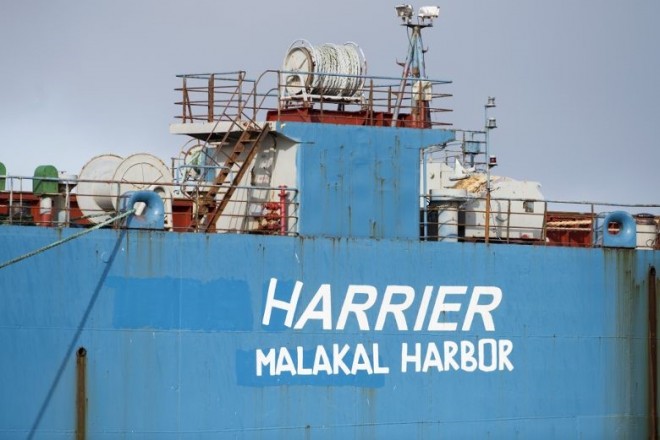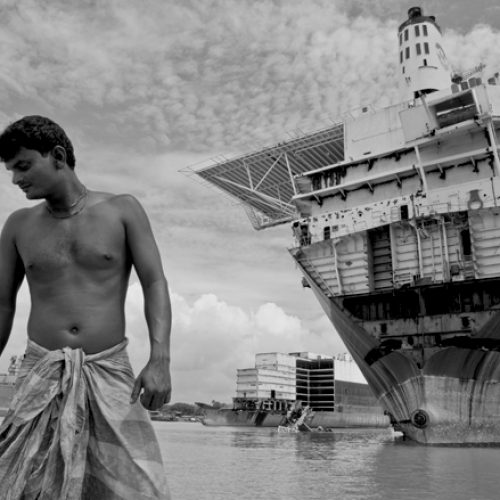Platform News – Investigations ongoing after Norwegian authorities press charges against owners of Harrier
The HARRIER is still under arrest in Norway after its owners failed to illegally set sail for the dangerous and dirty scrapping yards in Gadani, Pakistan, last February. The owners are now forced to find a safe and environmentally sound recycling destination. In parallel, investigations are still ongoing following the charges pressed by the Norwegian environmental authorities against the owners of the TIDE CARRIER for having attempted to breach existing waste trade laws [1].
At the edge of bankruptcy, Eide Group sold the previously named EIDE CARRIER, which had been laid up for 10 years, to cash buyer Wirana, a scrap dealer specialized in trading toxic ships to dirty and dangerous scrapping yards in South Asia. Wirana registered the vessel under an anonymous Saint Kitts and Nevis post box company called Julia Shipping Inc. The ship was renamed TIDE CARRIER and supposedly changed registry to the Paris MoU black-listed flag of Comoros. Based on fraudulent information that the vessel was heading for repair works in the Middle-East, Norwegian authorities allowed the ship to leave the west coast of Norway on 22 February 2017.
Had Wirana disclosed that the true destination was the beach of Gadani in Pakistan the vessel would not have been allowed to depart: exporting ships for dirty and dangerous scrapping is illegal under international waste trade laws. All ships contain many toxic materials within their structure and in their paints and the law requires that these should be managed in a way that protects people and the environment from harm. Extremely low operating standards at the beaching yards enable them to offer higher prices for the ships than facilities that operate in line with safety and environmental norms. Wirana knows this and the law very well, and for the sake of extra profits they therefore presented a fake contract for repairs in Oman.
However, the ship’s deteriorating condition caused the engine to stop only hours after its departure. Despite stormy weather, the vessel’s new captain from Nabeel Ship Management did not call for help. The risk of oil spill and grounding close to one of the most known beaches in Norway was high and was only dodged thanks to the Norwegian coastguard’s decision to trigger a salvage operation. An environmental disaster in Norway was avoided, and with the arrest of the ship in April the Norwegian authorities effectively averted another environmental injustice on the Gadani beach, where it was actually destined for scrap. Less than a year ago Gadani saw the worst shipbreaking catastrophe of the industry’s history[2].
Already in the summer of 2015, the Platform was informed that the vessel had been sold for breaking. Confronted with the illegality of exporting the ship to South Asia, Eide Group denied that the vessel would be scrapped at the time. One and a half years later, after the ship had been salvaged and was laid up in Gismarvik, the Environment Agency and the police found evidence that the vessel was under a “break up voyage” insurance from Norway to Gadani, Pakistan. That, and the fact that the contact person for Julia Shipping Inc in the sales contract that dated from summer 2015 is Keyur J. Dave, Chief Financial Officer at Wirana, are clear indicators that the vessel was headed to a scrap yard in Pakistan when it left Norway. All vessels broken in South Asia pass via the hands of a cash buyer. Singapore-based Wirana and US-based GMS are the two largest cash buyers, both of which are inherently entangled with the South Asian breakers.
Consequently, it became clear that the repair contract in Oman which had been provided to the Norwegian authorities as a way to escape checks for the illegal export of the vessel was false. The Norwegian Environment Ministry therefore rejected the complaint of Julia Shipping Inc, represented by law firm Wikborg Rein, for the arrest order. The post-box company Julia Shipping Inc refuses to reveal its ownership structure. To further point to the lack of accountability, the Norwegian newspaper, Bergens Tidende, revealed in a longer article, published in August, that when the Norwegian authorities had contacted the Comoros registry regarding the TIDE CARRIER, the Comoros registry answered that they did not have any information about the ship being registered under their flag. Only days later the vessel changed name again to HARRIER and swapped flags again to that of another Paris MoU black-listed flag: Palau. Both Comoros and Palau are popular end-of-life flags. In 2016, out of 668 ships that were beached, 42 had the flag of Palau and 47 were beached under the flag of Comoros. The now-called HARRIER is not allowed to leave Norway unless it is to sail to a ship recycling destination in line with international and European hazardous waste laws.
In the meantime the owners of the HARRIER owe the private port of Gismarvik and GMC Maritime several million NOK as port fees. The vessel left Gismarvik in June and is now anchored off the coast of Farsund where two crew members remain confined onboard the ship and the continuous use of the ship’s engine is creating unneglectable nuisance to local inhabitants.

This is not the first time that cash buyers seek to circumvent environmental protection laws by providing fake sales or repair contracts. The Norwegian owned CITY OF TOKYO was allowed to leave the port of Antwerp under the pretense of repair work in Dubai – instead it sailed directly to the infamous beaching yards in Bangladesh. The FPSO NORTH SEA PRODUCER was also illegally exported from the UK to Bangladesh under the pretense of further operational use in Nigeria. Cash buyer GMS used grey- and black listed Paris MoU flags and established anonymous post box companies in both cases.
The TIDE CARRIER case reveals the typical business practices of ship owners and cash buyers, and adds to several other cases where authorities have been lied to and provided false information as a way to escape checks for the illegal export of end-of-life ships. At least in the TIDE CARRIER case, the Norwegian authorities have so far not been gullible to fall for the well-known tricks of the game.
NOTES
[1] See the Norwegian environmental authorities’ press release.
[2] See also our release on a second accident that took place earlier this year.
Related news

Platform News – Platform launches fundraising campaign for afflicted workers
We are calling for your support to help injured workers and asbestos victims in Bangladesh.
... Read More
Platform News – European institutions call on EU to address decommissioning of floating oil and gas structures
A joint event between the European Economic and Social Committee (EESC) and three Green Members of the European Parliament highlighted the paradox between the strict rules… Read More

Press Release – Brazilian Navy suddenly seizes its old warship forcing it to sea
NGOs urgently call on President Lula to prevent Navy from sinking toxic ship in the Atlantic.
... Read More
Press Release – Two workers killed at Gadani shipbreaking yards
NGOs join trade unions in calling for enforcement of occupational health and safety standards.
... Read More
Platform News – Clean Shipping Coalition: Maersk undermines its reputation with plan to circumvent ship recycling law
The Clean Shipping Coalition criticises container ship giant Maersk for its statement that is considers to flag out end-of-life vessels from the Danish or other European registries… Read More

Platform publishes South Asia Quarterly Update #17
There were a total of 113 ships broken in the third quarter of 2018. Of these, 79 ships were sold to the beaches of South Asia for… Read More


